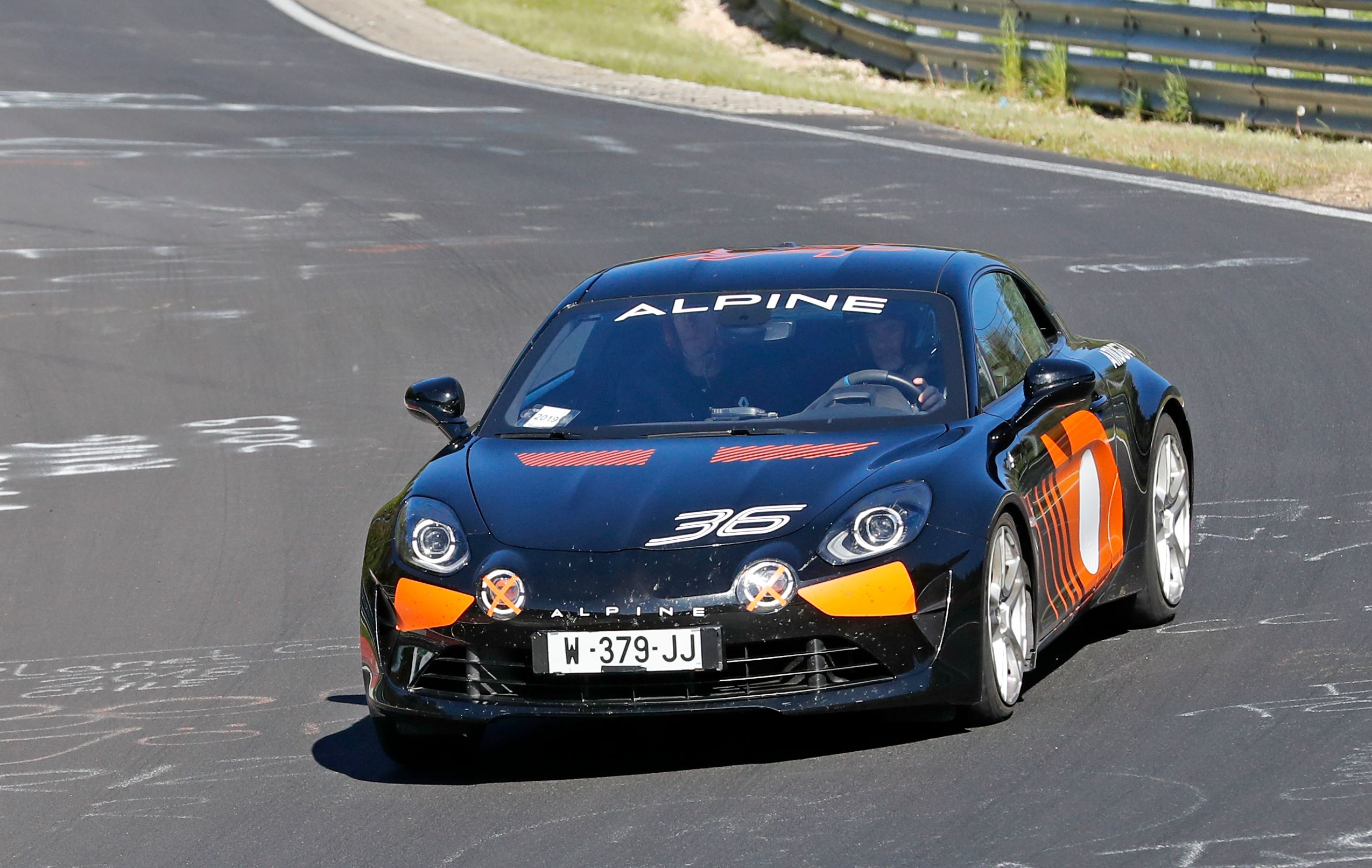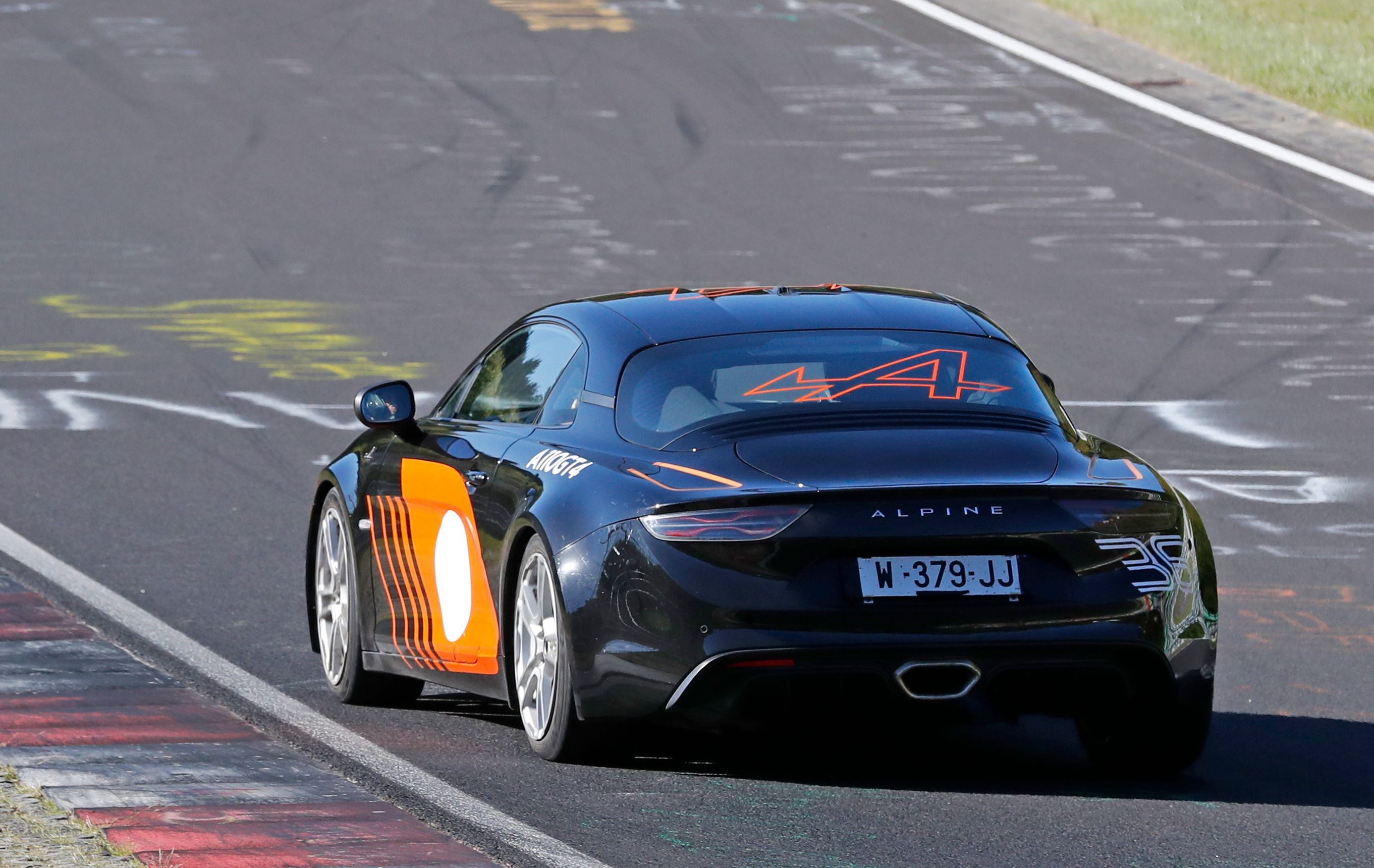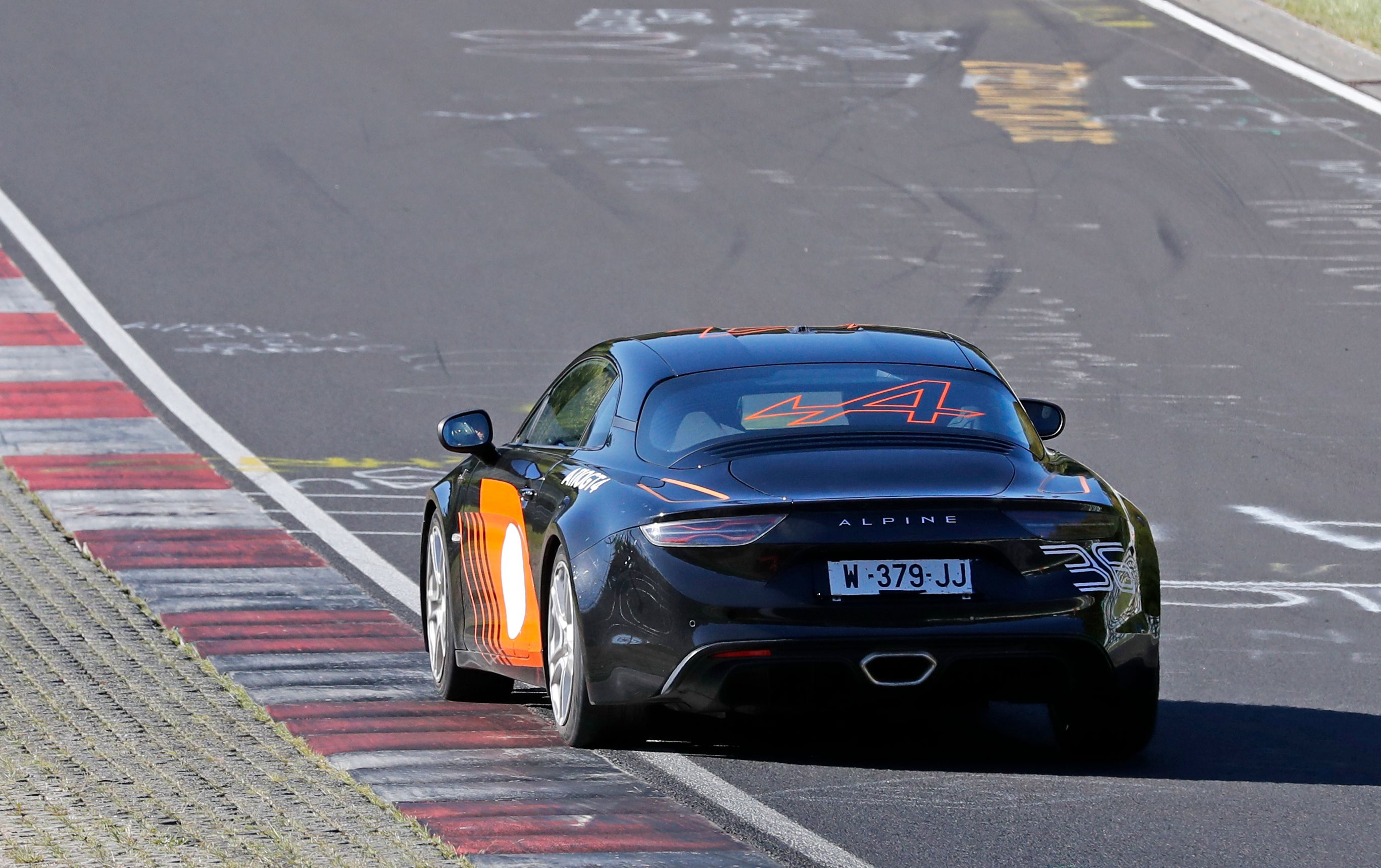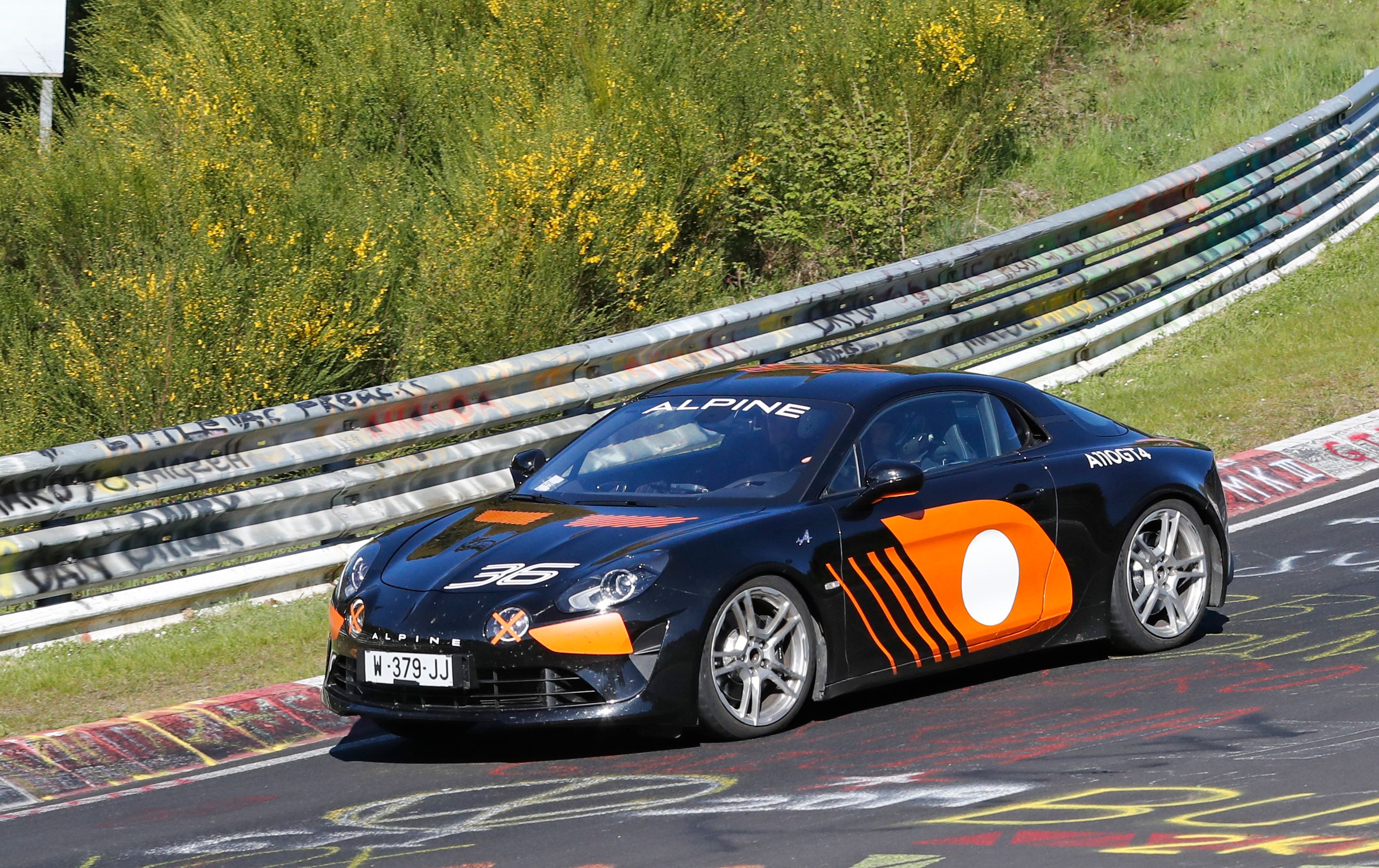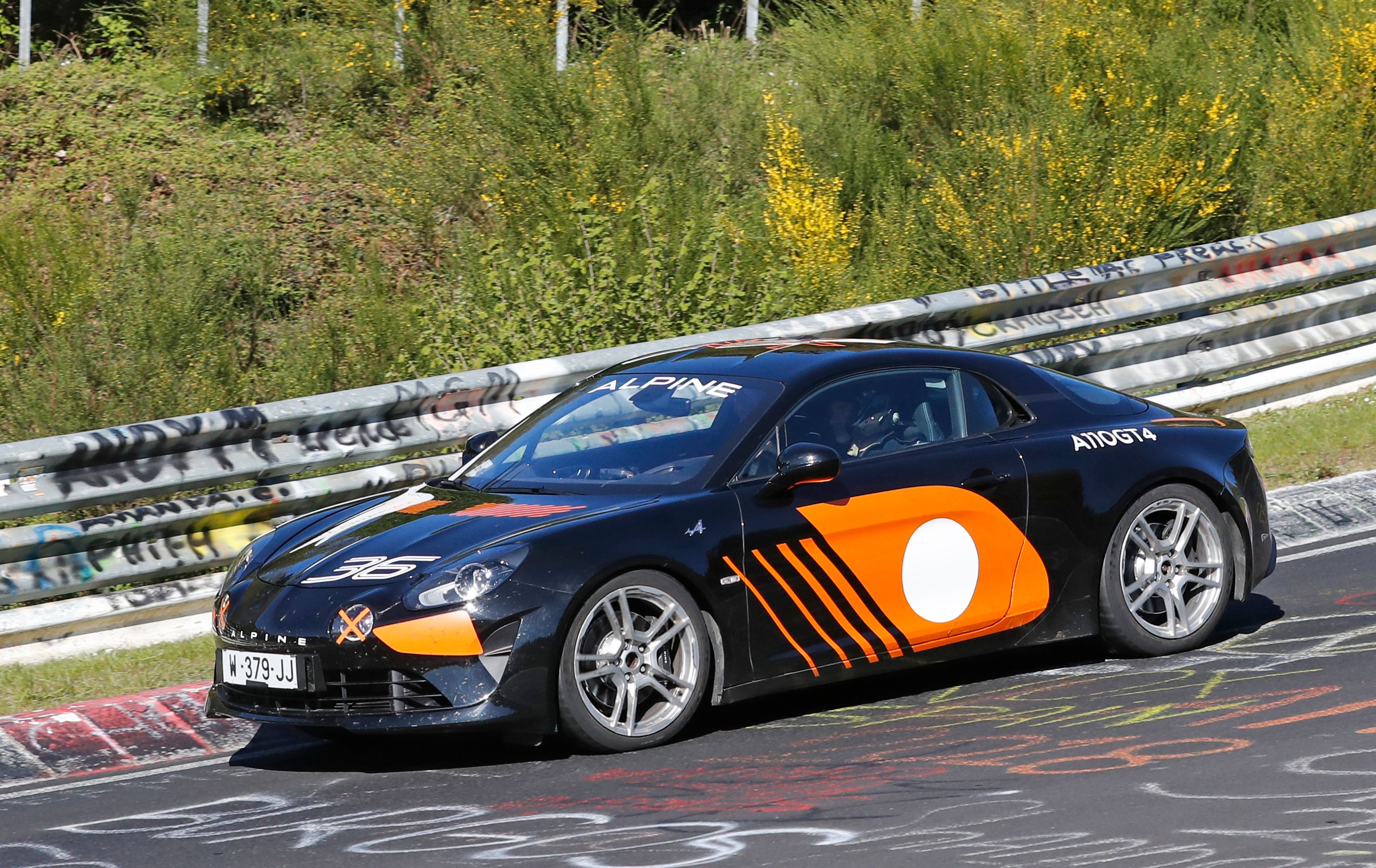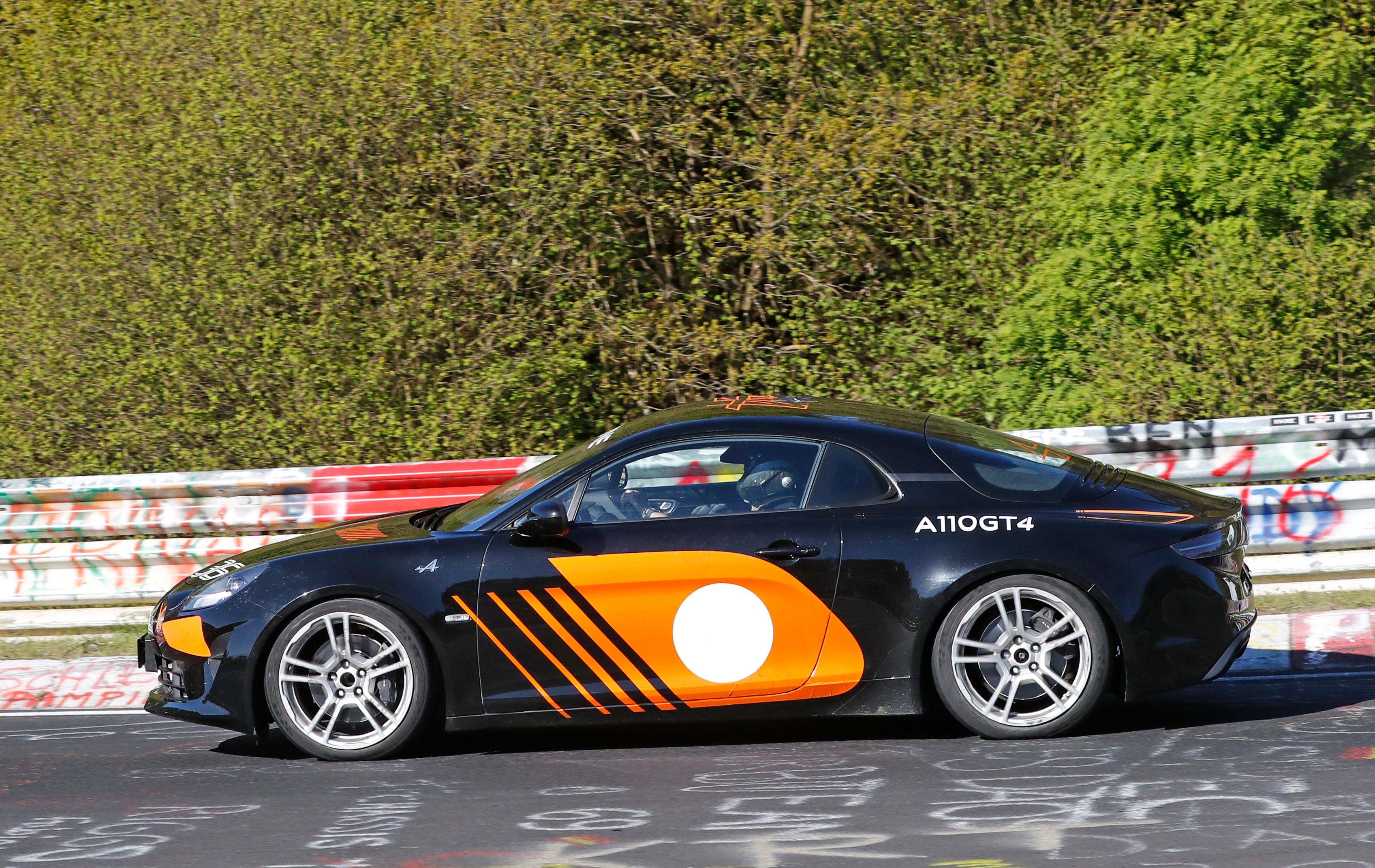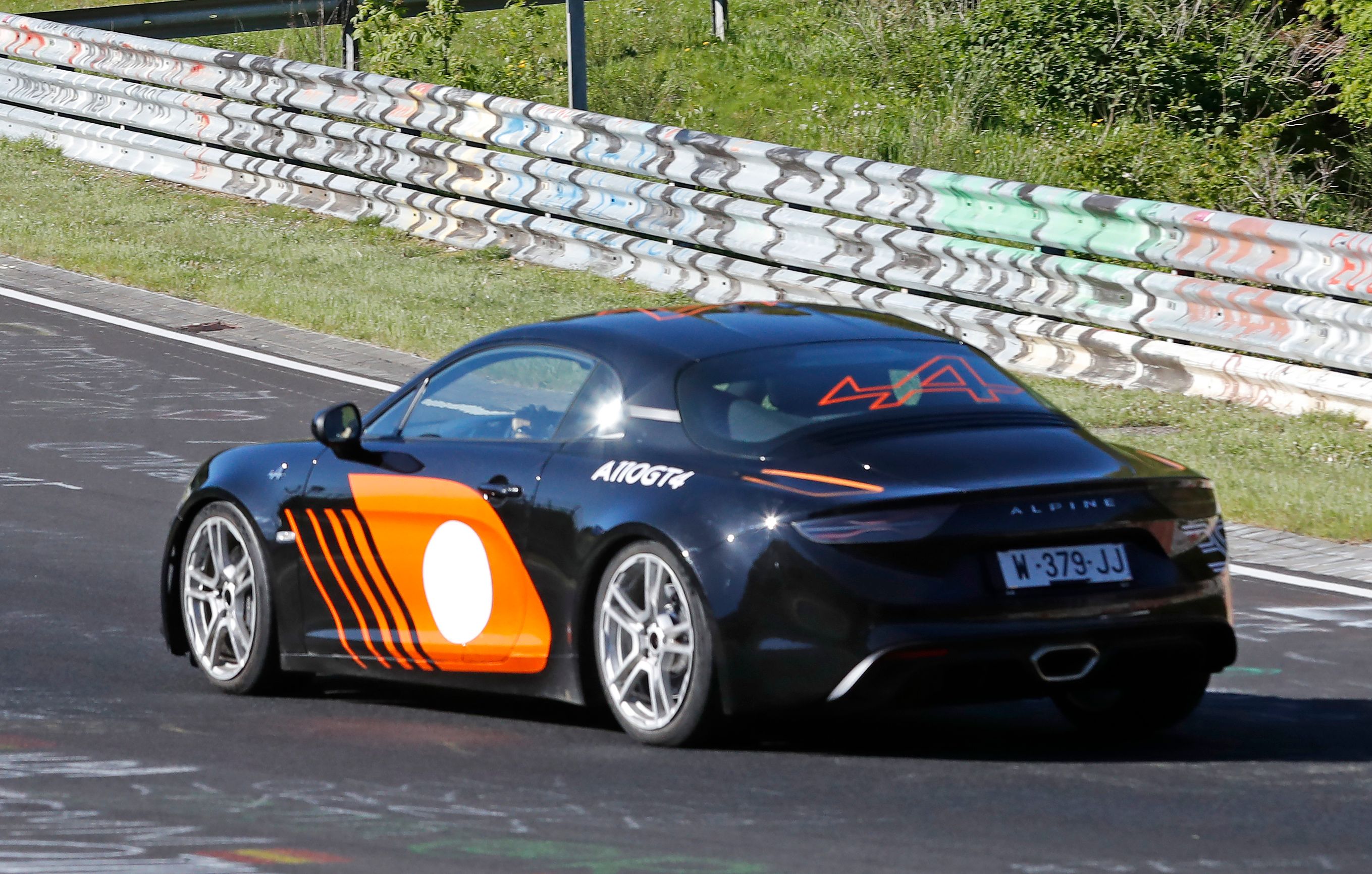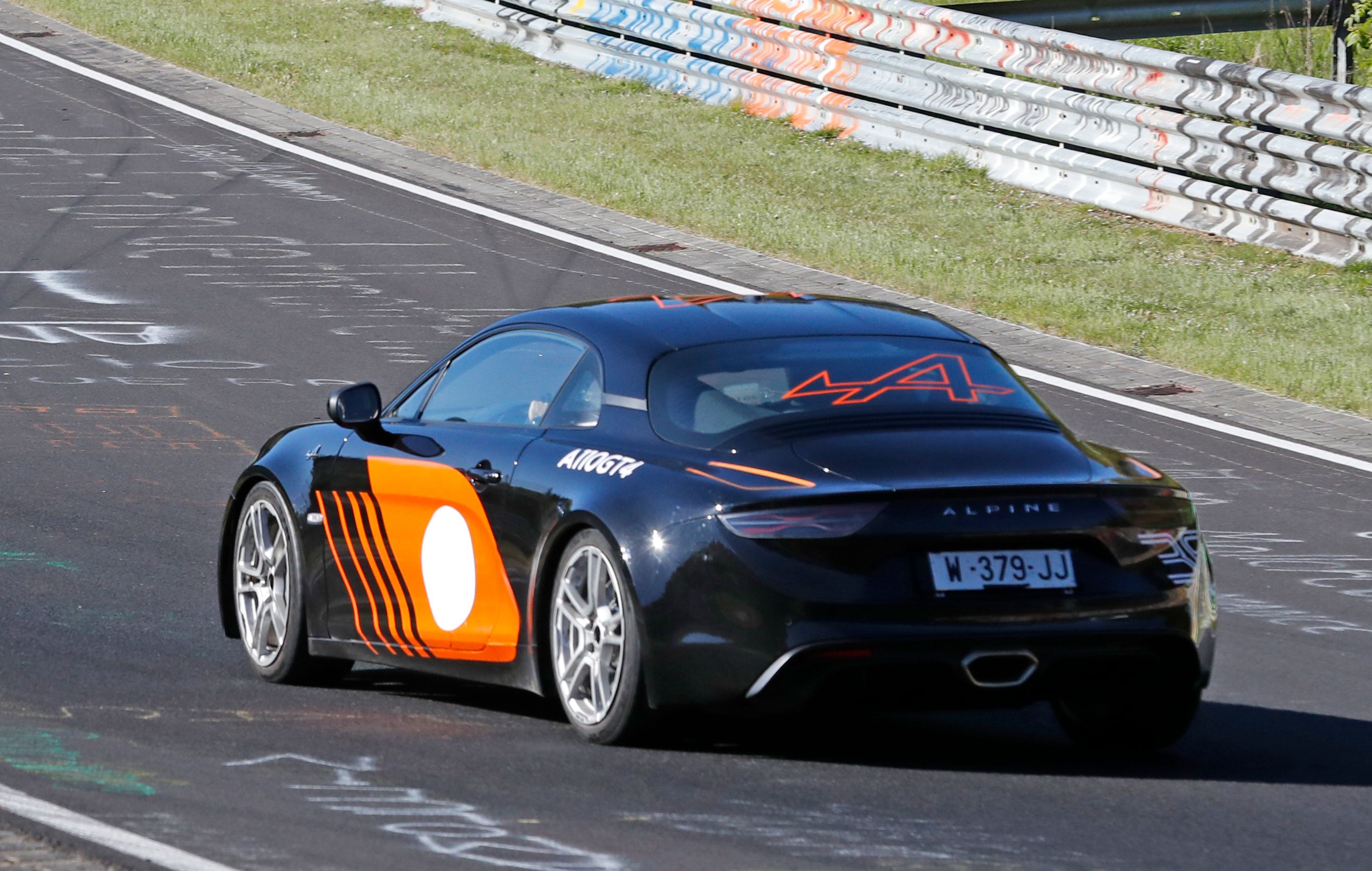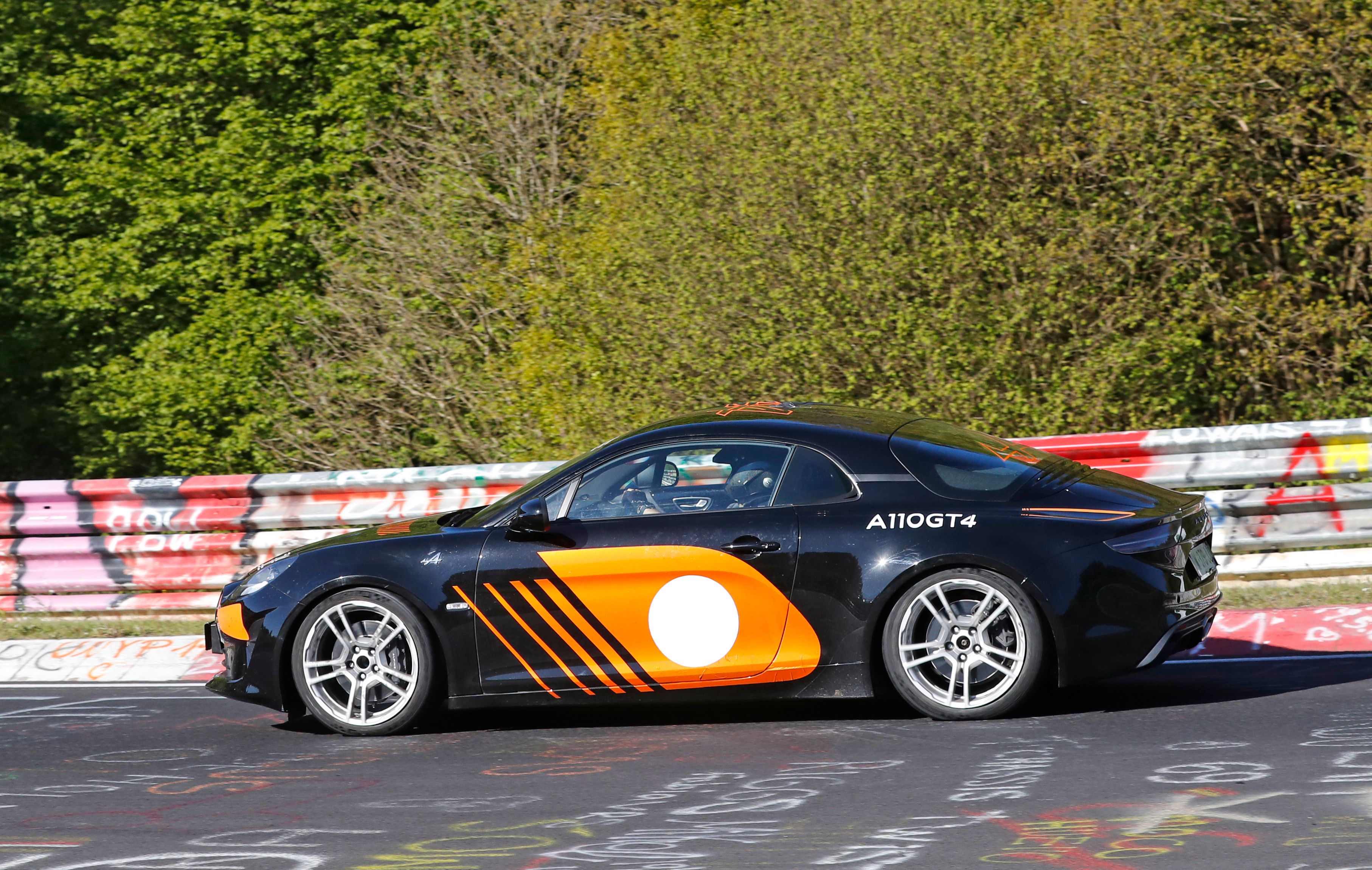The Alpine A110 is one of the best sports cars currently on the market; the only car one James May bought last year out of all of the machines he got to test. And for good reason. The French midship pocket rocket that packs a 1.8-liter, turbocharged engine delivering 249 horsepower and 236 pound-feet of torque sent to the back wheels through a seven-speed automatic box benefits from an awesomely balanced chassis and sharp steering that make it a true driver's car. Yes, there's no manual on offer right now, but the car you see in these spy shots could be the answer to our prayers for more oomph as Renault could be hard at work developing a track-oriented version of the A110. We're impatient!
When the Alpine A110-50 Concept broke cover in 2012, quickly followed by an Alpine-branded racing program in the European Le Mans Series and at Le Mans, we were wary at the prospect of a full-blown revival of the Alpine brand. You see, when Alpine was in its prime, the Renault-powered A110 1600 models were dominating the rally stages, and the car was a French symbol. Then, as years went by, Alpine kept its racing credentials by winning Le Mans outright in partnership with Renault but, on the road, the products moved away from the recipe that made the brand great. The A310 looked good, but the A610 of the '80s and '90s was just a cruiser. In a world of cars that get fatter by the day, pushed by safety regulations and the necessity to fill them to the brim with tech, we thought that a modern-day Alpine would just be a revival of the A610, an awkward, sluggish coupe that you either love or truly hate. Then we heard that it'll be named 'A110' and we crossed our fingers it won't tarnish that legendary name.
Then, when the car finally saw the light of day we were left drooling at its styling. It evoked the original while still looking fresh and, most important of all, it was tiny. It looked smaller than even an Alfa 4C or a Porsche 718 Cayman - Renault's benchmark when developing the A110 - and then people started driving the new Alpine, and the positive reviews started pouring. This time, though, it wasn't a case of pundits getting together to give empty applause to a car that doesn't deserve even a single-handed clap. No, the 2017 Alpine A110 is a well-sorted car that is deserving of the badge and of the heritage of the company founded by Jean Redele. A hotter version can only translate in a general tremble across the board from Audi's TT to Porsche's Cayman and everything in between.
2020 Alpine A110 Sport
- Make: Array
- Model: 2020 Alpine A110 Sport
- [do not use] Vehicle Model: Array
What are we actually looking at?
So hidden under a livery that you'd associate with the Alpine A110 GT4, this could actually be a prototype for a road-going version of the GT4 since it has numberplates on it. The question that arises is, will it then use the same engine as in the Megane R.S Trophy? Or will it be powered by an updated version of the A110's bespoke 1.8-liter four-pot?
If Renault will manage to cram the Megane's engine in the back end of the tiny Alpine that would translate to an A110 with 300 horsepower instead of 252 horsepower and a lot more fun - if you can keep it pointing in the right direction. Most likely there's some weight-saving going on there which can only make it even more fun. Not that the Alpine A110 is heavy with its 2,412-pound dry weight, but less weight is less weight, just ask Lotus about it!
So, assuming this isn't just a mule for an updated version of the bona fide, one has to wonder what they will call a sportier A110? Maybe 'A110 Sport'? Or what about 'A110 GT4 Street'? Porsche's been using the 'GT4' moniker on the Cayman (turned 718 Cayman) for a while already giving everybody headaches as the road car, the GT4 Cup car (made to run in a specific class in the German VLN endurance championship) and the proper GT4-spec car are all very similar. I guess we will have to wait until the Frankfurt Auto Show in September to find out.
Exterior
The Alpine A110 as drawn by Antony Villain and his team is a pretty car that doesn't exude aggressiveness the way an Alfa 4C does, for instance. It's got well-rounded proportions, a chiseled nose with quad headlights, the two smaller ones placed inboard a clear nod to the original from the '60s and '70s, and a cheeky and rounded tail section with an incorporated spoiler just above the taillights and after the edge of the trunk lid. Overall, it's one of the best-looking cars to be unveiled in 2017, but the GT4 version showed us that you can turn it into a mean machine too. All you need is a swan-neck rear wing, a lower front bumper with a protruding lip and a bigger mesh grille, and bigger wheels that are barely contained by the wheel arches.
Renault may follow that very recipe, albeit toned down a notch or two, with the A110 Sport, a car that we've been hearing about since the first months of 2019. The French have yet to officially announce that the model is, in fact, in the works but, earlier in May, a black test mule was spotted featuring some measuring equipment mounted to the wheels that suggests a beefier engine is resting under the hood, and the technicians are measuring its on-the-road performance.
Now, we're being flooded with images of another mule, again black, but, this time, covered in some orange graphics as well as white roundels on the doors, a huge, orange stylized 'A' on the rear window and a white racing number on the nose. So, what is it? Is it an updated version of the Alpine Cup that's been racing in the single-make Alpine Cup Europe series? It certainly isn't the actual GT4 racer (there're 'A110 GT4' graphics on the rear quarter panel above the rear wheel arches, but they're merely there to put you off) since that couldn't test on the Nordschleife on a day that's opened for the public since it's not a street-legal car.
This one, though, is and it, like the other black test mule, is fitted with a number plate that starts with a single W which, in France, refers to the fact that the car is an example that's part of a testing program or it is a demonstration car for a dealer. This means that we're looking at a new version of the A110 since the one that's already out there would not wear such plates as a fully registered model under French law - only new cars do.
Frankly, upon first glance, the number plate is the only thing that gives this car away. If anything, you could just guess this is some enthusiast's Alpine that was given a clever-looking racing livery as an ode to the racing cars since it almost doesn't differ in any way shape or form with a standard Alpine - be it in Pure, Premiere, or Legende trim levels. But, if you look closely, there are some things that stick out like the lip of the front bumper and the fact that the car sits lower than a standard Alpine (of course, as it's been photographed while cornering or braking, it's squatting or diving even more).
In the front, the Alpine A110 Sport looks familiar. The broad grille that extends along the width of the front bumper seems unchanged right down to the egg crate grille although the lower bumper seems somewhat different. Up above, the inboard headlights that sit on either side of the 'Alpine' name that's spelled out in chromed letters above the number plate holder are identical but, on this mule, they're crossed by two orange pieces of tape. There are also orange shapes placed underneath the headlights like on the A110 Cup. The two faux vents embedded in the corners of the front fascia and pushed inward a bit are still not functional and covered with a cheap-looking grooved piece of plastic.
The rounded LED headlights are unchanged as is the hood with its prominent ridge in the middle reminiscent of the design of the original Alpine penned by Giovanni Michelotti. On the old car, this ridge basically divided the hood and the whole nose of the car into two parts but this division is less evident on the modern car whose lines are a bit faded for a smoother look. The front hood, as I said, is left untouched barring for the racing number placed in the lower right corner and what seem to be air vents simulated using more orange tape just below the windshield - is it an indication that the A110 Sport, when ready, will feature a new hood with extra vents? It's hard to believe this will be the case since there's no engine under that front lid and, anyway, the interior is getting enough air as it is, it'd be a major design fault if that weren't the case and one that would've been addressed a lot earlier.
From the side, the Alpine also looks familiar. It features orange decals that follow the C-shaped caved-in area across the doors - another historical reference to Michelotti's original design. Over the orange decals, there are white (and empty) roundels that further try to imply that this is a race-going machine. It sports the 18-inch 10-spoke wheels you could find on the Premiere Edition A110 but without the matte black touches. I suspect these aren't the actual wheels that will adorn the wheel wells of the A110 Sport when it will be unveiled.
There is another orange decal on the double bubble roof and, also, during its test runs, the mule featured some duct tape that ran along the pillar aft of the side window and onto the roof which probably hid some sort of wire for data acquisition and transmission. Oh, and yes, the black strip across the back pillar that's supposed to give you the feeling that the A110 comes with a "floating roof" is still there although we wished it wasn't as it's utterly useless and I think I've only ever seen one car recently that actually makes use of that bar in a way that's not obnoxious.
In the back, things have remained largely the same. There are some orange stripes on top of the front fenders - maybe a place where future forward-facing vents will be carved, like on the A110 1600S of yesteryear? - as well as an orange Alpine logo that covers the entirety of the rear window but that's about it. The teardrop-shaped headlights are the same as is the mid-mounted and chromed exhaust tip that's not like the ones on the A110 Cup and the A110 GT4, further hinting at the street-bound nature of this car. The diffuser, too, is quite civil with two main vertical elements although I could bet it will become more aggressive before the car's actually introduced. On top of that, it will probably work with a fixed wing on top of the trunk lid as the test mule was seen running with one, a minimized version of the swan-neck wing used on the GT4 racer.
2020 Alpine A110 Sport exterior dimensions
|
Wheelbase |
95.2 inches |
|---|---|
|
Length |
164.5 inches |
|
Width |
70.8 inches |
|
Height |
49.3 inches |
Interior
If you expect a truly bare-bones experience inside the Alpine A110 Sport, you might be in for a surprise. While reports say that the sportier version will shed 110 pounds-worth of interior trim pieces and other unessential bits and pieces, don't expect to find empty interior door panels adorned with just a piece of cloth to pull the door once you're in (like on some 911 GT3 RS models) nor should you look forward to a full-blown roll-cage as you'll be disappointed.
Yes, the A110 Sport will have a sportier interior, but it won't look like the cockpit of a Cup car. While we have no actual images of the cabin at the time of writing, from the exterior shots, we can see that the interior is fairly standard. You can see, though, the presence of what looks like a lap timer on top of the dash and you can also spot the fact that the steering wheel features a blue go-forward stripe, but that's nothing new, in fact.
The standard Alpine features a digital gauge cluster behind the wheel, a raised center consoles with the controls for the infotainment system, which, in turn, is displayed on the screen positioned in the middle of the dashboard. On the center console, there are also controls for the seven-speed, Getrag-developed automatic transmission. There are buttons for "Drive," "Neutral," and "Revers," and also the Start/Stop button. Everything looks neat and somewhat upmarket, although some buttons in the lower part of the dash look cheap and betray their Renault origin. The seats, however, can't be found in any Renault. Any A110 comes with bespoke Sabelt bucket seats adorned with old-school cross-haired leather upholstery that weight just 29 pounds each. The seats inside the A110 might be lighter, and you may see some stuff behind the seats disappear in a bid to save weight.
Drivetrain
Since Renault is yet to even confirm this car, we can't really tell you too much about what'll hide under the skin of the A110 Sport, but some things from the standard car are surely there to stay, such as the all-aluminum chassis. We're not sure if the Sport version will get carbon fiber parts but, in the case of the standard one, the body panels are aluminum too and, since the car's small (8.6 inches shorter than a 718 Cayman, yet still some 6.5 inches longer than the Alfa 4C), the weight is down to just 2,412 pounds. Considering weight reduction won't be limited to the cabin, expect the Sport version to weigh less than 2,200 pounds - this is still over 200 pounds heavier than the European-spec Alfa 4C (the American one weighs already 2,300 pounds) but also about 750 pounds lighter than the Cayman.
Most of that weight sits in the back, 56% of it to be precise, as that's where the engine is. What is the engine? A 1.8-liter, turbocharged, four-cylinder in the standard version, one that can put out 249 horsepower at 6,000 and 236 pound-feet of torque between 2,000 and 5,000 rpm. Due to the low weight, though, a standard A110 in its lightest trim level (Pure), can go from naught to 62 mph in 4.5 seconds en route to a top speed of 155 mph. What will the Sport version bring?
Supposedly, 50 more ponies and about 60 torques from the engine of the Nurburgring-breaking Renault Megane R.S. Trophy-R. That sounds like fun, especially if the driving modes will also be tweaked. Now, when I say "from the engine of the Megane" I don't envision a genuine engine swap, these two cars share the block but the A110 sports its own air intake, turbocharger, exhaust system, and engine tune, so I guess the A110's engine will be updated too like the one in the Trophy-R was.
Currently, the most serene mode is the Normal mode and, if you want to really be able to thrash it around, you have to switch to the Sport mode or the Race mode for the least amount of traction control intervention. As a light car with the bulk of the weight towards the back, you'll see that it does want to get sideways (and it can get a bit wiggly on the highway if you're passed by the odd semi).
Suspension is by double wishbones at both ends, and this will probably remain the status quo although I'd expect to see different spring rates and less forgiving dampers (but not adaptive, I don't think so, at least). Now, in Normal mode, the seven-speed Getrag automatic shifts low and this allows you to get 37 to 40 mpg in the city which is surprising, but the Sport version is bound to be a lot more hungry.
Top Gear said about the A110 that "in reality, it’s very convincing: the way it goes down the road, the fluidity, the delicacy, the adjustability and accuracy all makes the 2.0-liter Cayman feel borderline clumsy." Granted, that Cayman produces 210 horsepower per tonne while the A110 with 249 horsepower on tap produces 226 horsepower per tonne thanks to its lightweight. What this means is that, in short, a hotter Alpine could try and tackle the Cayman GT4, at least in terms of driving sensations if not lap times on a track.
For the record, the Alpine A110 Cup already has 266 horsepower, so you know the engine's got potential. Also, the little racer features an LSD and a six-speed sequential box for good measure. And it also has bigger brakes, 13.18 inches in diameter versus just 12.6 inches on the road car. Also, it's 66 pounds lighter - less than what the Sport should lose from the cabin alone, but the Cup car comes with a built-in FIA-graded roll-bar and a fuel cell.
IMSA Weathertech Sports Car Championship regular and Konica Minolta WTR Team Cadillac driver Renger van der Zande of the Netherlands drove the A110 Cup car at Zolder and had this to say about it: "It kind of drives like a kart: the car will always turn in, and oversteer on entry is easy to handle. It’s very forgiving and feels like you can play around with it which is exactly what you’re looking for in this car." And this is how he'd compare it to a Cayman: "Most Porsches are built to go very fast while being safe and feel precise. The Alpine feels precise as well, but still feels playful and somewhat loose at the same time, which makes for a very fun drive." His conclusion, though, might surprise you: "To be honest, I even like the street version better than the race version. If you fit the streetcar with slicks, you’ll have a fantastic car." In other words, if the Sport is a step above the A110 you can get if you live in Europe, we're in for a head-bending experience!
2020 Alpine A110 Sport drivetrain specifications
|
Engine |
1.8-liter, turbocharged, four-cylinder |
|---|---|
|
Output |
300 horsepower |
|
Torque |
296 pound-feet |
|
0-62 mph |
4.0 seconds |
|
Top speed |
160 mph |
|
Suspension |
double wishbones all around |
|
Gearbox |
seven-speed automatic, dual clutch |
|
Weight |
Below 2,250 pounds |
Prices
The A110 Cup I've just talked about as a way to give you a preview of how the A110 Sport might feel (but on street rubber, obviously) costs a whopping $113,662 but do not despair - the A110 in stock trim ranges between $62,180 (Pure) and $66,480 (Legende). You may say that's a lot because, indeed, the Cayman starts at just $55,300 here in the U.S., but if you want the 718 Cayman S that manages to trump the A110s performance, you'll have to pay $67,700.
Meanwhile, the Alfa 4C costs $66,900 before you start adding options and the soon-to-be-retired Audi TT (with its 2.0-liter, turbocharged four-pot that puts out 288 horsepower and 280 pound-feet of twist for a 0-60 mph time of 4.4 seconds) will set you back anywhere between $44,900 and $66,900 - the price of a TT RS with 335 horsepower and 332 pound-feet on tap from a turbocharged inline-five. Also, consider that a BMW M2 costs $60,000, but it's not as exotic as the other two.
Competition
Porsche Cayman GT4
Now, I've talked a lot about how the Alpine A110 compares with the Cayman but, in my view, the A110 Sport must set its sights at the 718 Cayman GT4 (not the RS version, though). The 2019 model year features a 4.0-liter that makes over 400 horsepower. The old Cayman GT4 was powered by a 3.8-liter mill that put out 385 horsepower so, in other words, Alpine's job will be tough, really tough.
The outgoing model needed 4.2 seconds to reach 60 mph but the 2019 one needs under four, and the top speed is said to be 185 mph - 30 mph more than the standard Alpine's 155 mph top speed. Oh, and Porsche will still offer it with a manual and with the PDK as the optional transmission. Finally, the 2019 weighs less than the 2,954 pounds of the 981 Cayman GT4, but all these things (including the GT3-esque aerodynamic package with that big wing in the back) is reflected by the price. If the old model cost $81,400, the 2019 Cayman GT4 won't be yours unless you can fork out at least $85,000 and that's almost $20,000 more than the most expensive A110. I don't think the A110 will be that expensive and this is what could be the deciding factor: on the one hand, you've got the French car that will still be lighter and somewhat more fun (manual-free though) and, on the other, the faster Porsche but that will be more expensive too.
Read our full speculative review on the 2020 Porsche Cayman GT4
Conclusion
I'm a fan of the Alpine A110. May called it "the greatest thing to come out of France since the Mouli cheese grater," and I tend to agree that it's France's best sports car in a while, a rather long while at that. The car, as it is, is already a treat to drive, one that rewards you if you know what you're doing behind the wheel but can be very civil and laid back for everyday use. The Sport version ought to be more rugged, but if all the extra power and torque will be kept in check by the chassis via stiffer suspension and all, we can forgive it for being more of a track toy. After all, the Porsche Cayman GT4 is exactly the same thing.
Further reading
Read our full review on the 2017 Alpine A110
Check out more details on the Alpine A110 GT4 Concept.

